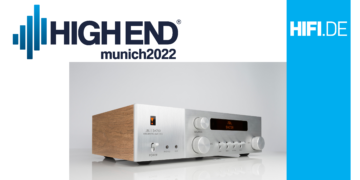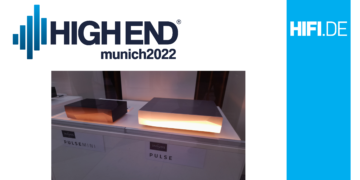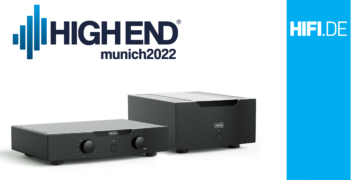| HIFI-FORUM » Veranstaltungstechnik (PA) » Studio / (Home-) Recording » Gesang rausschneiden | |
|
|
||||
Gesang rausschneiden+A -A |
||
| Autor |
| |
|
Albert-Weizel
Stammgast |
#1
erstellt: 27. Mai 2007, 09:13

|
|
|
Hallo Weiß net ob ich hir richtig bin. Aber wie bekomme ich nur den Sound von einer Musik bzw. denn Gesang rausgeschnitten |
||
|
fischmeister
Inventar |
#2
erstellt: 27. Mai 2007, 17:47

|
|
|
Normalerweise ist das praktisch unmöglich, es sei denn, du verfügst über seeeeehr ausgefeilte, spezielle (und natürlich auch extrem teure) Tontechnik. Relativ einfach ist es manchmal bei 5.1-Musik-DVDs möglich. Da wird nämlich speziell bei Live-DVDs oft der Sänger auf den Center-Kanal gelegt, während der Rest der Musik auf den übrigen Kanälen liegt. Hier musst du also nur den Center-Kanal ausblenden, und schon ist der Gesang weg. |
||
|
|
||
|
djpartyteam
Inventar |
#3
erstellt: 27. Mai 2007, 18:08

|
|
|
geht schon goldwave 5 macht dass Problem ist aber dass ja lle Frequenzen die im slben Frequenzband wie die Stimme liegen danach weg sind. ausserdem hörst du immer noch ein bisschen Stimme. gehe lieber auf die Suche nach dem passenden Instrumental hast du mehr davon |
||
|
Gene_Frenkle
Inventar |
#4
erstellt: 28. Mai 2007, 19:36

|
|
|
Es gab mal von Roland/Boss Hardware, die so etwas für Stereo machte. Im Prinzip wird dabei das Signal, dass genau in die Mitte gemischt ist (meißt Stimme und Solo-Instrumente) herausgeschnitten, wobei noch ein Tiefpassfilter den Bass durchlässt, da der Bass meißt auch genau in die Mitte gemixt ist. Wenn die Stimmme mit Stereoeffekten bearbeitet ist, funktioniert das ganze natürlich nicht so gut. Zwei Musikstücke, wo es nur mit dem Balance-Regler geht: The Beatles: Girl und Nancy Sinatra: Bang Bang. |
||
|
20is
Stammgast |
#5
erstellt: 31. Mai 2007, 00:04

|
|
|
Ich habe im Internet mal einen bericht gefunden, worum es darin geht das Accappella mit hilfe der Instrumental Version freizustellen. Hier der Text dazu.... Dsico How to: No.2 DIY ACAPELLAS Find an instrumental version of the track. CD Singles are the best source, as the digital recording & pressing techniques are more likely to give a perfect copy of the backing track, which is something that you need. Mp3s are not likely to give good results as the compression method removes some of the audio data that may be required. Recording from vinyl may work if you do both recordings under exactly the same conditions (any pitch variation will reduce the effectiveness of this technique). Just rip the audio tracks to wav files, or another uncompressed format, .AIF etc, using an Audio Extracter/Ripper. The basic idea relies on the linear superposition of audio. Which is simply: that if you have take a sound, any sound at all, and add it to the inverted version of itself the result will be silence. Note: Occasionally the instrumental on the CD Single will have a slightly different arrangement or structure. basically you are screwed in this case. (it won't be this simple but you may be able to salvage something). A rough guide when you're considering buying that CD single is "Are the two tracks exactly the same length?" if they are, then there is a good chance the engineer just muted the vocal track when they did the instrumental, which could result in a nice clean acapella. Step 2: Matching Them Up Now that you have the Instrumental Version its a matter of mathcing the two songs exactly. i.e. to the sample. The best thing for this is a wave editor like Soundforge, Peak, Cooledit,......etc Radio version vs Instrumental As you can see these two look pretty close except for the vocal sections. Thats a good start. By zooming in on the first beat of the Radio Version you get a better picture of the shape of the waveform. You want to find a distinctive little waveshape that you can then look for in the instrumental (or vice versa). for example I just focussed on this little click at the begining of the track: Find a Distinctive Waveform Shape After you find the same section in the second track you can start trying to line them up so that the spikes fall on EXACTLY the same sample position. Personally I just delete sections from the beginning of either until the sample no. readout of the spikes is exactly the same. This makes it much easier to do the "paste mix" later. Match Up the Two Tracks Step 3 : Mix 'Em Together The rest is rather simple, just invert one of the tracks, say the instrumental, ("Select All" then apply an "Invert Waveform" function or similar) and mix the inverted instrumental with the orignal aligned radio version the result may be a pretty clean acapella. to Mix the two: In Soundforge I just select the entire song (try and find a "Select All" command). Now copy that into the clipboard. ie just Copy it. ("Ctrl + C" or "Option + C"). Select the other version from the begining of the track and PASTE MIX or similar type function. You may need to fiddle with the repective volumes of the two as there may be differences in the mastered loudness. Thats about it. The idea is that now that they are aligned it is very easy to do a paste mix where the two waveforms will fall directly ontop of each other (but inverted) and hence cancel out. This will leave only the difference between the two (the vocal) Although there will most likely still be some semblance of drums and stuff through into the acapella, This is probably due to post production mastering differences (multiband compression, maximising reverb etc..) between the Instrumental version and the radio edit. I've also noticed ther is often some nasty digital noise, its low in the mix but you can hear it in the straight acapella, I've been curious as to why that is there, and well I don't know. It could be due to dither (which is the process of purposefully adding noise to digital recordings) as it should be random each time so it won't cancel out. Invert As you can see its a pretty simple process. But its the only way to get a reasonably clean and good quality vocal from a full mixed track. Just a couple of notes on some other rumoured methods of creating acapellas: 1. EQ out the Backing: I've heard people talk about EQing the backing track out of the mix, utter bullshit. It can't be done without destroying the vocal as well. The tonal range of the human voice is also within the range of most musical instruments it will never work. 2. Karaoke Versions: There was an old school method to create a vocal free version of a song. Which relied on the notion that the left and right channels of most instruments are well out of phase however the vocal as it is mono and mixed center is not. Thus mixing say, the right channel with an inverted left will result in a vocal free version. This will give you an "instrumental" or a rough one. You can not use that in this process: some simple algebra will explain why it will not work. A little EQ afterwards will help clean it up and maybe a touch of multiband compression to emphasis the vocal and add some dynamic noise reduciton. Otherwise you could be sweet. By the way, I noticed that the Eminem "Cleaning OUt my Closet" CD Single has an Acapella that is exactly the same length as the vocal version. Haven't tried myself but I almost bought it for that single reason. |
||
|
punkrocks
Stammgast |
#6
erstellt: 31. Mai 2007, 07:03

|
|
|
Die beschriebene Technik funktioniert aber nur, wenn man z.B. auf einer CD-Single sowohl das Original-Lied als auch eine fertige Instrumentalversion hat. Das ist aber wahrscheinlich eher seltener der Fall... Wenn man wirklich nur das Original-Lied hat, ist es schon ziemlich aufwändig und das Ergebnis schwankend... |
||
|
Gene_Frenkle
Inventar |
#7
erstellt: 31. Mai 2007, 11:00

|
|
Ich glaube der Threatersteller wollte aber genau das Gegenteil, nämlich eine Instrumentalversion. Im letzten Teil wird darauf ein wenig eingegangen, allerdings wird der Highpass-Filter vergessen, was dazu führt, dass kein Bass in dem erstellten Instrumental/Karaokeversion sein wird. Das hilft auch "A little EQ afterwards ... and maybe a touch of multiband compression" nicht mehr. |
||
|
CK][
Ist häufiger hier |
#8
erstellt: 01. Jun 2007, 23:26

|
|
|
Hi, Die Stimme kannst du auf jeden Fall nur mit sehr professionellen, extrem teuren Geräten bzw. Software verlustfrei rauschneiden, da sie akribisch genau die Haupt und die dazugehörigen Nebenfrequenzen der Stimme erkennen muss. Alles andere hat eher Karaokequalität - Es wird also wie gesagt auch alles andere auf dem Frequenzband der Stimme rausgeschnitten. Von daher praktisch kaum machbar. Du wirst dir wohl eine Quelle suchen müssen wo du instrumentals her bekommst. Meine Musiklehrerin kann z.b. für die meisten Sachen sowas besorgen. mfg Chris |
||
| ||
|
|
||||
| Das könnte Dich auch interessieren: |
|
Melodie von Gesang trennen *Morte* am 06.05.2015 – Letzte Antwort am 14.06.2015 – 5 Beiträge |
|
Kaufberatung: Gesang aufnehmen %user%§-22x am 18.02.2016 – Letzte Antwort am 18.02.2016 – 7 Beiträge |
|
Aufnahme von Klassischem Gesang + Klavier isengart am 23.11.2008 – Letzte Antwort am 09.01.2009 – 18 Beiträge |
|
Gesang Recording (Equipment) Tom1686 am 18.12.2010 – Letzte Antwort am 23.12.2010 – 15 Beiträge |
|
Mobiles Aufnahmegerät für Gesang ??? oktavian1 am 19.03.2006 – Letzte Antwort am 24.03.2006 – 7 Beiträge |
|
Homerecording klassicher Gesang D.Düsentrieb am 21.10.2011 – Letzte Antwort am 25.10.2011 – 4 Beiträge |
|
Interface für Gesang (NT2A) Curel am 09.01.2007 – Letzte Antwort am 08.12.2011 – 6 Beiträge |
|
Aufnahme von Rock und Gesang Cruel-Intention am 08.02.2011 – Letzte Antwort am 08.02.2011 – 2 Beiträge |
|
Brauche Equipmentratschläge (f. Gitarre + Gesang) MomoTheSheep am 25.04.2008 – Letzte Antwort am 29.04.2008 – 17 Beiträge |
|
Gesang-Mikrofon für PC Skipweb am 18.02.2007 – Letzte Antwort am 26.03.2007 – 4 Beiträge |
Anzeige
Produkte in diesem Thread

Aktuelle Aktion
Top 10 Threads in Studio / (Home-) Recording der letzten 7 Tage

- warum rauschen studiomonitore?
- Harten Sound aufweichen -> alter Studio-Trick
- TRS statt TS Instrumentenkabel für Instrumente/Amps ein Problem?
- Für Karaoke, wie Mikrofon und TV anschliessen?
- Mixing: Was taugen alte B&W CDM 1 Boxen vs aktuelle nahfeldmonitore
- USB-Mic an Verstärker/Mischpult?
- XLR,RCA und TRS was ist das bessere, unterschiede?
- mikrofon nimmt kein sound auf
- H2 Zoom Recorder - Übersteuerungen?
- Reichen Studiomonitore oder benötigt man einen Subwoofer
Top 10 Threads in Studio / (Home-) Recording der letzten 50 Tage

- warum rauschen studiomonitore?
- Harten Sound aufweichen -> alter Studio-Trick
- TRS statt TS Instrumentenkabel für Instrumente/Amps ein Problem?
- Für Karaoke, wie Mikrofon und TV anschliessen?
- Mixing: Was taugen alte B&W CDM 1 Boxen vs aktuelle nahfeldmonitore
- USB-Mic an Verstärker/Mischpult?
- XLR,RCA und TRS was ist das bessere, unterschiede?
- mikrofon nimmt kein sound auf
- H2 Zoom Recorder - Übersteuerungen?
- Reichen Studiomonitore oder benötigt man einen Subwoofer
Top 10 Suchanfragen

Forumsstatistik

- Registrierte Mitglieder928.540 ( Heute: 11 )
- Neuestes MitgliedArikanda
- Gesamtzahl an Themen1.558.458
- Gesamtzahl an Beiträgen21.702.759










